Samudra - Scintillating Dance extraordinaire


Text by Ashanti OMkar (www.omkari.net)
Pictures by Akin Falope (www.aworan.net)
Great quality contemporary Indian dance is something that one rarely gets to see, especially in the UK, but one could barley touch the surface of what was in store when top South Indian fusion dance group, Samudra’s ‘Sound of Silence’ tour was announced, to be performing all over the UK. A special treat for the eyes and ears is putting it very mildly. Thanks to SAMPAD, the South Asian Arts company founded by the artistically and academically brilliant Piali Ray OBE, the illustrious choreographer and staunch arts lover, known for taking around UK some of the best musical and arts ventures, imparting some of the elements that make Indian culture so enriching, to the NRI (Non resident Indian) population and also commanding the attention of non Asians, to further learn and watch some of the wonders of ancient Indian art forms and their modern adaptations. Providing access not only to watching these amazing shows, but also facilitating numerous ways in which to learn more and interact with accomplished artistes via workshops, Sampad had established itself as one of UK’s leading South Asian arts organisations. A cross cultural bridge is also brought about, where the tours may consist of the cream of Indian crop showcasing their work alongside some of UK’s upcoming dance companies, in this instance, alongside Samudra were, African jazz, martial arts and street dance, Lola Adodo and Patel Hithwardak Manal Youth Group who combine Gujarati traditional and Bollywood style dance.
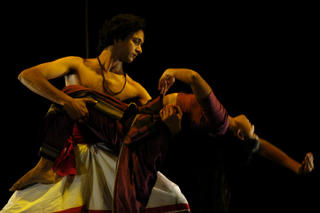
Over 3000 years ago, far removed from our society of today, South India was the place where Sage Parasurama, the master of all martial art forms resided. His ‘Kalaripayattu’ form of martial arts was shrouded in secrecy, yet considered by many as the oldest in its genre and is said to have transcended into more modern forms of Kung Fu via Bodhi Dharma, an Indian Buddist Monk, who took it to the Shaolin Temple in China. Bodhi Dharma’s teachings brought about the physical and spiritual elements that make up the practice of Kung Fu today and forged a formidable regime that made the students of the martial art not only physically strong, but also mentally able. How does all this come into play in the modern day India, one may ask and the secret lies in Kalaripayattu, as it has had an insurgence in the flourishing, tropical area where it originated, Kerala, and the masters who take it around the world have proven themselves to be a force to reckon with. Like the popular Brazilian martial art cum dance form, Capoeira, Kalaripayattu, the much older of the arts is gaining more and more interest from the West, for its incredible movement and the sheer concentration required by the performers who put it on stage. It taps into the healing forces of Ayurvedic herbal medicines and massage, which indubitably hold the key to keeping the practitioners in peak physical condition, as the sights that their dance and movements behold are no mean feat.
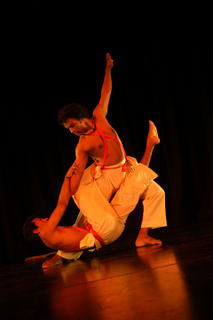
The animal forms of the wild boar, snake, lion, tiger, elephant and crocodile all constitute in the movements that make up this form and from its rightful home, South India’s most beautiful and lush secret, Kerala, come acclaimed dance groups like Samudra who are sharing the beauty and grace of the form, combining other Indian art forms like Bharathanatyam, Yoga, versions of arty masked dance and Rope Mallalhamb (the idea of traversing a rope and forming Yogic positions while hanging with total composure, in mid air) with the world, gaining not only popularity but also critical recognition for their outstanding vision.

1998 was the beginning of Samudra, the collaborative brainchild of 2 like minded and talented creative individuals Madhu Gopinath and Vakkom Sajeev of Trivandrum, Kerala, who decided at a young age, as neighbours and longstanding friends, to dedicate their life to arts, supported by their Parents in this futuristic vision, they have gone on to prove their worth by taking their unique and often jaw-dropping shows around the world, some of the venues they are performed at include London’s legendary Royal Opera House, the Iddac theatre festival of France, the Spoleto and Biennale festivals of Italy, L’Inde in Portugal and Spain, Hong Kong and Malaysia, all over India at many prominent venues and of course, all over UK with this tour. This being a strenuous tour that has been demanding physically, but sees both Madhu and Vakkom Sajeev smiling and greeting the audiences who have been most impressed by their incredible feats of dance. Dance is incomplete without it’s sister art, that being music, and the addition of Kalamandalam Anand, the talented music director completed their initial company, which has now expanded into over 11 performers, all with their own nuances and talents bringing colour, depth and dimension to their already special work. Imagination and innovation being the key to their astonishing choreography, they have already been snapped up by Bollywood for the celebrated film by eccentric but illustrious artist MF Hussain - ‘Meenaxi’ (known well for its song by British Asian singer, Reena Bhardwaj with music by AR Rahman, ‘Yeh Rishta’).
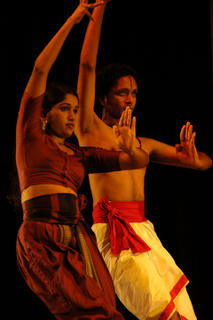
The award winning ‘Sound of Silence’ production (winning amongst 65 countries entries in Italy) has been in existence since the conception of Samudra and in its uniqueness, it was conceived, in the words of Madhu Gopinath and Vakkom Sajeev, to be: “The mother - life force - a dialogue between movement, sound, body and soul - we wanted to blend the traditional arts with a modern twist and we took the concept of Life Chakra, which means wheel of life and break it down into the stages - we have sensuality, contradictions, the breaking of earthly chains and temptations, the attaining of enlightenment - ultimately it is our perception of the universal truth being obtained by means of sound and silence - both are necessary, like the yin and the yang - the divine spirit of an individual obtained, by movement and moment.” They describe with vitality and a glint in their eyes: “It has been a little tiring but fantastic, we have been enjoying this tour immensely, meeting people from so many walks of life and many different age ranges. The very first performance at the Leicester Expo, in the open air, with people walking around tested our concentration skills, to keep our posture and precise movements, but we were able to draw the energy from the crowds’ response and it was an experience to remember.” At the prestigious and newly re-built ‘Bharatiya Vidya Bhavan’ in London, with their new auditorium and seating, the diversity of audience was very evident, especially seeing the young daughters of Kathak exponent Gauri Sharma Tripathi, reacting to the dance they were watching, by chuckles at the masked dancing and showing that the art was connecting them to the performance on stage - an achievement in itself. On being asked about their simple but visually aesthetic costumes, they say: “we both design these ourselves, as we know the movements and know what sort of designs will enhance and accentuate our choreography.” In terms of the production itself, they describe: “The cross legged Yogic posture called Padmasana is done while Vakkom is high up on the rope and ‘Om’, the universal, most primordial sound, the uttering known as mankind’s first word is chanted in the background. The Gayatri Mantra from the Rig Veda, which is an ancient sacred Sanskrit invocation that has the power of ‘illumination the intelligence’ has had dance movements set to it, precise and in total concentration, our dancers perform.” Along with 2 more able dancers from the Samudra team, a beautiful young lady with the most captivating eyes and graceful Bharathanatyam poses, M.S Deepa and a newer member of the team, G.Sabarigiri, who definitely competently complemented Vakkom and Madhu.
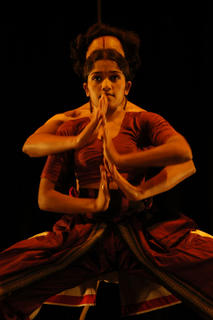
In terms of the musical aspect, there were some lovely touches from the live musicians, though TS Lazar and S Dasan had not joined on this tour. Directed by the very capable Kalamandalam Anand, the renowned Chenda player (the Chenda is a typically Keralan percussion instrument, with a distinctive sound, which is played with sticks) and master percussionist worked his magic, showing how important percussion is in accentuating dance. He was joined by vocalist Kavalam Sajeev and violinist A.S Sreekumar, who gave the ears a treat, with some pieces that they peppered as a trio in between the dance pieces. Treated to a very South Indian musical fest, featuring a rare Keralan Raga named by Kavalam Sajeev as Samamdha Manohari, which is different to the popular Carnatic Raga Nattai by Paryoga only (nuances) and the Raga Soorya (AKA Sallabam), a wonderful piece in the Raga Vasantha, a titillating Bageshree Raga, and a lovely Revati Raga rendition to name a few. Some of the music came in tracks, but most were performed live, with most curious use of a bamboo instrument, a creation of Kalamandalam Anand, the sound that it brought was that of someone ‘playing’ their cheeks, amongst an array of other percussion sound effect instruments!
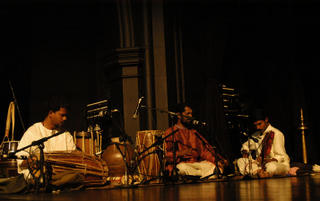
Samudra is obviously going places, literally, with their vision, capability and sheer hard work - “We have given our lives to dance and every day, we work hard to bring it to the world. We want to invent more and more new dance productions, and enhance on those already in existence like ‘Sound of silence’ and ‘Jalam’, our tribute to water, in our tradition, water is a revered mother and without her, like the other elements, there would be no existence.” So say this very philosophical and intelligent group of artistes, who are not just dancers or choreographers, but people who possess an innate wisdom, which one can attribute to their ancient traditions and heritage, Kerala in South India is definitely put on the world map, with such ambassadors as Samudra.
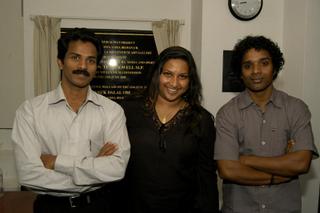
All images are (c) AWORAN (www.aworan.net) and are not to be taken off this Blogspot without photographer's permission. The words are by Ashanti OMkar (www.omkari.net) - please contact via website email for permission if they are to be reproduced and credit must be given to the author and photographer if reproduced anywhere else on the web. They are subject to UK copyright laws and as this was a piece published in a UK newspaper, the words are copyrighted too. Thank you.
